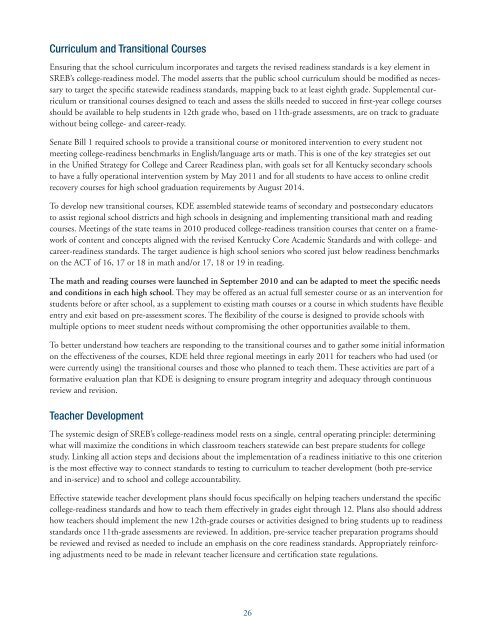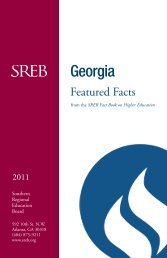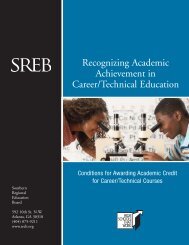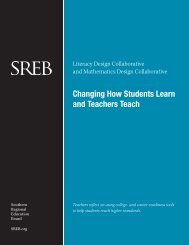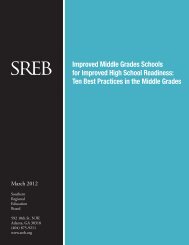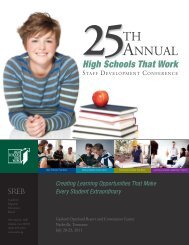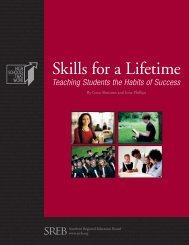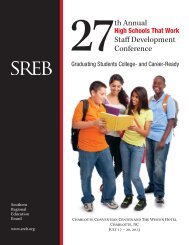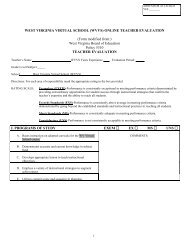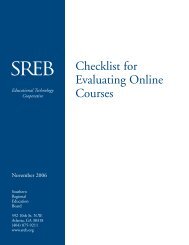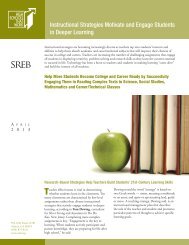Final Progress Reports - Southern Regional Education Board
Final Progress Reports - Southern Regional Education Board
Final Progress Reports - Southern Regional Education Board
You also want an ePaper? Increase the reach of your titles
YUMPU automatically turns print PDFs into web optimized ePapers that Google loves.
Curriculum and Transitional Courses<br />
Ensuring that the school curriculum incorporates and targets the revised readiness standards is a key element in<br />
SREB’s college-readiness model. The model asserts that the public school curriculum should be modified as necessary<br />
to target the specific statewide readiness standards, mapping back to at least eighth grade. Supplemental curriculum<br />
or transitional courses designed to teach and assess the skills needed to succeed in first-year college courses<br />
should be available to help students in 12th grade who, based on 11th-grade assessments, are on track to graduate<br />
without being college- and career-ready.<br />
Senate Bill 1 required schools to provide a transitional course or monitored intervention to every student not<br />
meeting college-readiness benchmarks in English/language arts or math. This is one of the key strategies set out<br />
in the Unified Strategy for College and Career Readiness plan, with goals set for all Kentucky secondary schools<br />
to have a fully operational intervention system by May 2011 and for all students to have access to online credit<br />
recovery courses for high school graduation requirements by August 2014.<br />
To develop new transitional courses, KDE assembled statewide teams of secondary and postsecondary educators<br />
to assist regional school districts and high schools in designing and implementing transitional math and reading<br />
courses. Meetings of the state teams in 2010 produced college-readiness transition courses that center on a framework<br />
of content and concepts aligned with the revised Kentucky Core Academic Standards and with college- and<br />
career-readiness standards. The target audience is high school seniors who scored just below readiness benchmarks<br />
on the ACT of 16, 17 or 18 in math and/or 17, 18 or 19 in reading.<br />
The math and reading courses were launched in September 2010 and can be adapted to meet the specific needs<br />
and conditions in each high school. They may be offered as an actual full semester course or as an intervention for<br />
students before or after school, as a supplement to existing math courses or a course in which students have flexible<br />
entry and exit based on pre-assessment scores. The flexibility of the course is designed to provide schools with<br />
multiple options to meet student needs without compromising the other opportunities available to them.<br />
To better understand how teachers are responding to the transitional courses and to gather some initial information<br />
on the effectiveness of the courses, KDE held three regional meetings in early 2011 for teachers who had used (or<br />
were currently using) the transitional courses and those who planned to teach them. These activities are part of a<br />
formative evaluation plan that KDE is designing to ensure program integrity and adequacy through continuous<br />
review and revision.<br />
Teacher Development<br />
The systemic design of SREB’s college-readiness model rests on a single, central operating principle: determining<br />
what will maximize the conditions in which classroom teachers statewide can best prepare students for college<br />
study. Linking all action steps and decisions about the implementation of a readiness initiative to this one criterion<br />
is the most effective way to connect standards to testing to curriculum to teacher development (both pre-service<br />
and in-service) and to school and college accountability.<br />
Effective statewide teacher development plans should focus specifically on helping teachers understand the specific<br />
college-readiness standards and how to teach them effectively in grades eight through 12. Plans also should address<br />
how teachers should implement the new 12th-grade courses or activities designed to bring students up to readiness<br />
standards once 11th-grade assessments are reviewed. In addition, pre-service teacher preparation programs should<br />
be reviewed and revised as needed to include an emphasis on the core readiness standards. Appropriately reinforcing<br />
adjustments need to be made in relevant teacher licensure and certification state regulations.<br />
26


